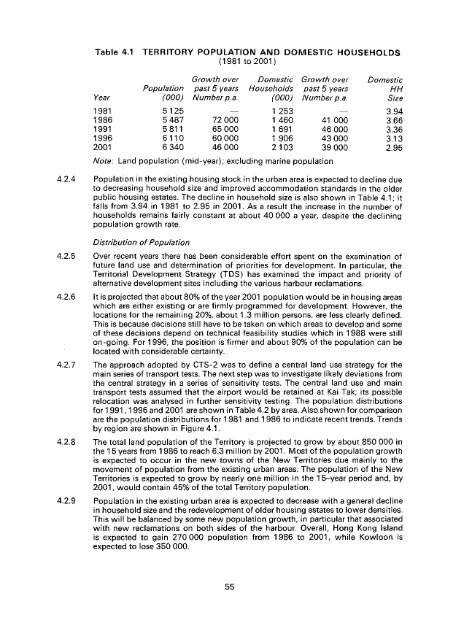Untitled - HKU Libraries - The University of Hong Kong
Untitled - HKU Libraries - The University of Hong Kong
Untitled - HKU Libraries - The University of Hong Kong
- No tags were found...
You also want an ePaper? Increase the reach of your titles
YUMPU automatically turns print PDFs into web optimized ePapers that Google loves.
Table 4.1(1981 to 2001)Growth over Domestic Growth over DomesticPopulation past 5 years Households past 5 years HHYear (000) Number p.a. (000) Number p.a. Size1981 5125 ' — 1 253 — 3.941986 5487 72000 1460 41000 3.661991 5811 65000 1691 46000 3.361996 6110 60000 1906 43000 3.132001 6340 46000 2103 39000 2.95Note: Land population (mid-year); excluding marine population4.2.4 Population in the existing housing stock in the urban area is expected to decline dueto decreasing household size and improved accommodation standards in the olderpublic housing estates. <strong>The</strong> decline in household size is also shown in Table 4.1; itfalls from 3.94 in 1981 to 2.95 in 2001. As a result the increase in the number <strong>of</strong>households remains fairly constant at about 40000 a year, despite the decliningpopulation growth rate.Distribution <strong>of</strong> Population4.2.5 Over recent years there has been considerable effort spent on the examination <strong>of</strong>future land use and determination <strong>of</strong> priorities for development. In particular, theTerritorial Development Strategy (TDS) has examined the impact and priority <strong>of</strong>alternative development sites including the various harbour reclamations.4.2.6 It is projected that about 80% <strong>of</strong> the year 2001 population would be in housing areaswhich are either existing or are firmly programmed for development. However, thelocations for the remaining 20%, about 1.3 million persons, are less clearly defined.This is because decsssons still have to be taken on which areas to develop and some<strong>of</strong> these decisions depend on technical feasibility studies which in 1988 were stillon-going. For 1 996, the position is firmer and about 90% <strong>of</strong> the population can belocated with considerable certainty.4.2.7 <strong>The</strong> approach adopted by CTS-2 was to define a central land use strategy for themain series <strong>of</strong> transport tests. <strong>The</strong> next step was to investigate likely deviations fromthe central strategy in a series <strong>of</strong> sensitivity tests. <strong>The</strong> central land use and maintransport tests assumed that the airport would be retained at Kai Tak; its possiblerelocation was analysed in further sensitivity testing. <strong>The</strong> population distributionsfor 1991,1996 and 2001 are shown in Table 4.2 by area. Also shown for comparisonare the population distributions for 1 981 and 1986 to indicate recent trends. Trendsby region are shown in Figure 4.1.4.2.8 <strong>The</strong> total land population <strong>of</strong> the Territory is projected to grow by about 850 000 inthe 15 years from 1986 to reach 6.3 million by 2001. Most <strong>of</strong> the population growthis expected to occur in the new towns <strong>of</strong> the New Territories due mainly to themovement <strong>of</strong> population from the existing urban areas. <strong>The</strong> population <strong>of</strong> the NewTerritories is expected to grow by nearly one million in the 15-year period and, by2001, would contain 45% <strong>of</strong> the total Territory population.4.2.9 Population in the existing urban area is expected to decrease with a general declinein household size and the redevelopment <strong>of</strong> older housing estates to lower densities.This will be balanced by some new population growth, in particular that associatedwith new reclamations on both sides <strong>of</strong> the harbour. Overall, <strong>Hong</strong> <strong>Kong</strong> Islandis expected to gain 270000 population from 1986 to 2001, while Kowloon isexpected to lose 350 000.55
















